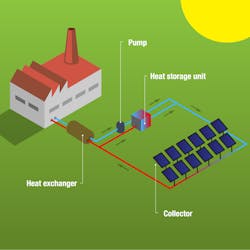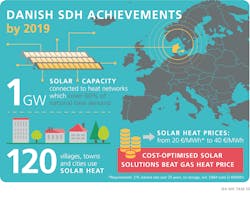A Green Future for Europe: The Silent Revolution of Solar Thermal
Energy transition is one of the hot topics in the European political debate, and surprisingly or not, it’s not all about electricity. Those who think so are missing the big picture of our system. In Europe, 47% of the final energy demand is represented by heating and cooling, compared with 28% for transport and only 25% for electricity.
Looking at future trends, these percentages are likely to change but what still remains clear is that the decarbonization of our energy system wouldn’t be possible without fully decarbonizing the heating and cooling sector. Nowadays, only 19% of this sector is based on renewables. However, several technologies are already available, such as solar thermal, providing direct renewable heat in a cost-effective way, which shows huge potentials for further deployment.
Solar Thermal: Good for the Environment and the Economy
Solar thermal is a technology with multiple benefits. In brief, it produces direct renewable heat without any carbon dioxide (CO2) emissions. The most common use for this renewable heat is the supply of hot water or space heating in the residential sector. This technology is also extremely scalable, ranging from decentralized domestic systems with a 2-kW capacity, to large scale plants in the megawatt-thermal range for solar-assisted district heating (SDH) and solar heat for industrial processes (SHIP), which are particularly developed in Central and Northern Europe.Going beyond the environmental aspects, solar heating also brings economic advantages by creating local jobs and replacing imports of fossil fuels. Additionally, it can be combined with other technologies and solutions. These different aspects make it a no regret option in the current and future energy mix.
For example, a single domestic solar thermal system in Greece can save up to 1.5 tons of CO2 per year, which is equivalent to the emissions produced by one car in Europe every year. Furthermore, the components of a solar thermal system are almost 100% recyclable or reusable, contributing to its low-carbon footprint.
Find more explanatory factsheets about solar thermal applications here.
Enabling Systems Integration
Besides being highly sustainable, solar systems present another big advantage: they are easily compatible with renewable and fossil technologies, both in the heating and the electricity sector. For instance, a solar collector can be coupled with a heat pump. Using solar heat as the main source and the heat pump as a backup during the winter season will increase the heat pump’s lifecycle while making the overall system more energy efficient.
Another smart application would be adding a solar collector to a gas boiler to reduce the consumption of the boiler and its emissions. When the need to replace the boiler arises, the solar thermal system can be kept and combined with other green solutions, making the system 100% renewable.
Adding solar thermal to your energy system will always lead to a direct reduction of primary energy consumption and lower lifecycle costs.
Forget the Flexibility Issue Thanks to Thermal Storage
As mentioned before, solar heat is also compatible with electrical solutions, such as solar photovoltaic (PV). It’s important to note that solar thermal systems always include a thermal storage unit as a built-in feature to cope with daily, and in some cases, seasonal variations.
Therefore, thermal storage can play a key role in reducing peak demand in the electricity grid and compensating energy fluctuations. It acts as a technology enabler that allows further integration and can facilitate sector coupling.
Not Just for Southern Countries: Denmark, a Success Story
When thinking about solar thermal, it is common to fall into the preconceived idea that solar thermal is just effective in "warm countries." On the contrary, one of the best examples in the European market is Denmark, where solar thermal systems connected to district heating networks and using a seasonal storage can provide solar heat at a cost below 3 cent/KWh.
Similar results can also be reached by solar water heaters in Southern Europe. On the other hand, the heat generation via a gas boiler costs between 28 to 35 euros/MWh (US$30.35 to US$37.94/MWh) and gas prices are likely to increase in the future, while those of solar energy are not.
A European Technology and a Net Exporter Sector
Every year, around 2 GW of solar heat is installed in Europe, meaning a 2 billion euros (US$2.2 billion) turnover based mainly on local manufacturing and local jobs. Germany alone exported 5.2 billion euros (US$5.6 billion) worth of products and components between 2000 to 2015, while Greece manufacturers export over 60% of their production annually.
Although China remains the leader in the global market, Europe is a net exporter to South America, Africa, and China itself, among others, thanks to high-quality standards of European technology. In fact, approximately 90% of products in the EU market are of European origin and this is a key factor for European industrial leadership while ensuring the security of our energy supplies. Overall the market is showing positive trends and growing in Denmark, Poland, and Southern Europe.
2030 as a Milestone
There are several signals showing a change in people’s behavior in embracing green solutions. Member states must make citizens aware of the existing alternatives, so that they will be able to choose renewable options instead of polluting ones. Heating systems have an average lifetime of 15 to 20 years. Therefore, all fossil-based systems installed in 2030 are likely to be still active (and polluting) in 2050. Urgent actions are needed.
First of all, public authorities should promote the planned replacement of heating systems and allow citizens to choose in advance among the best renewable options. Usually consumers change their systems when these break down. And the systems are more likely to breakdown during winter when their use is more intensive. This situation creates an emergency, requiring urgent replacements. The time constraints seriously limit the options, and, in most cases, consumers maintain a similar system to the one they had before, generally using fossil fuels.
What's Next?
Renewable heating and cooling solutions are expected to take a prominent role in achieving a 2050 decarbonized system. Finally, we see in Europe a stronger commitment to renewables and climate, as witnessed by the European Green Deal or the New Pact for Climate announced by the president-elect of the European Commission, Ursula von der Leyen.
A silent revolution is happening in Europe, in search of solutions for our climate challenge. While heating is half of the energy problem, renewable heat and solar thermal in particular are a fundamental part of the solution.














